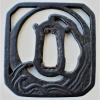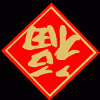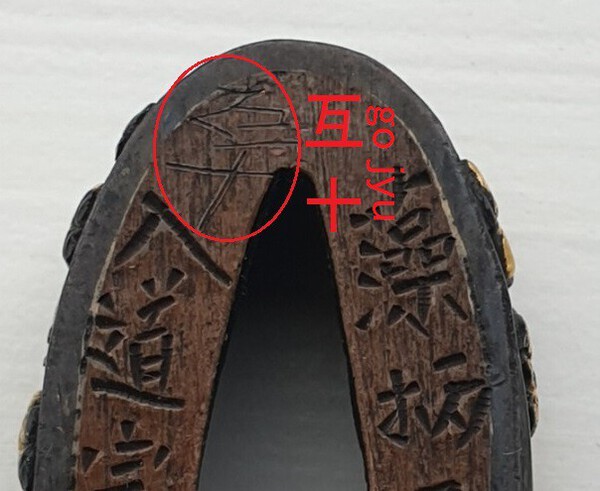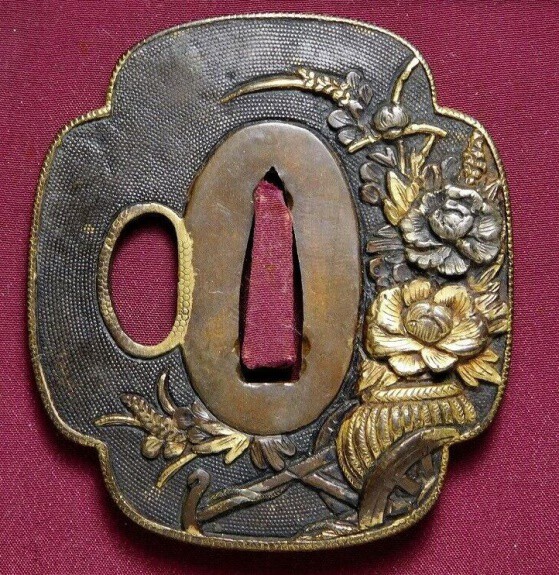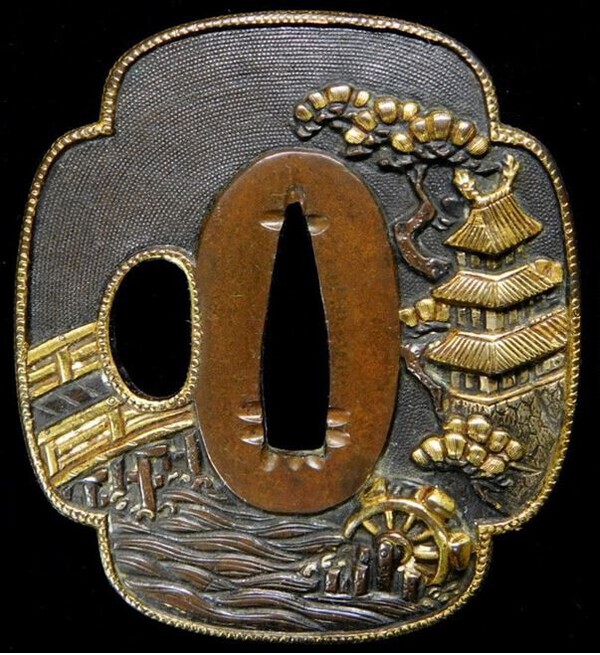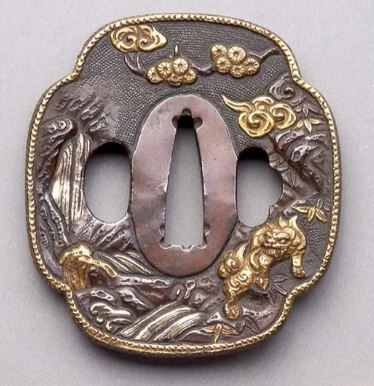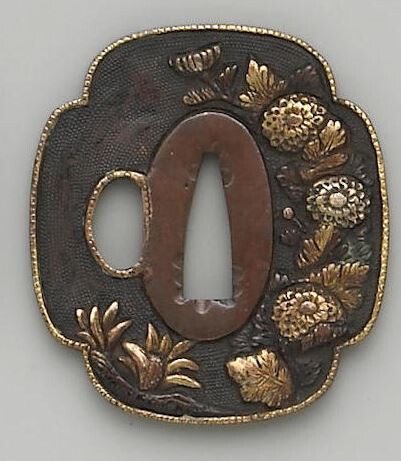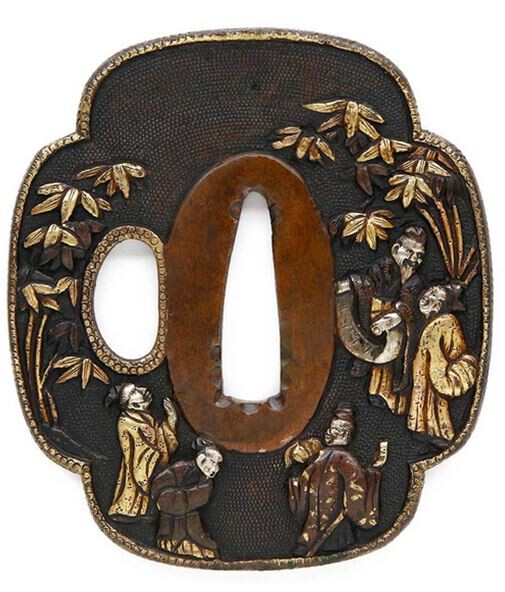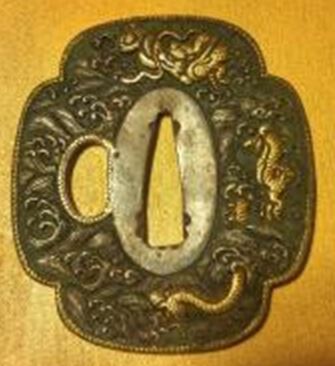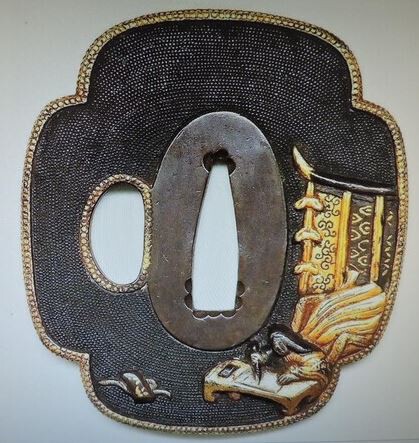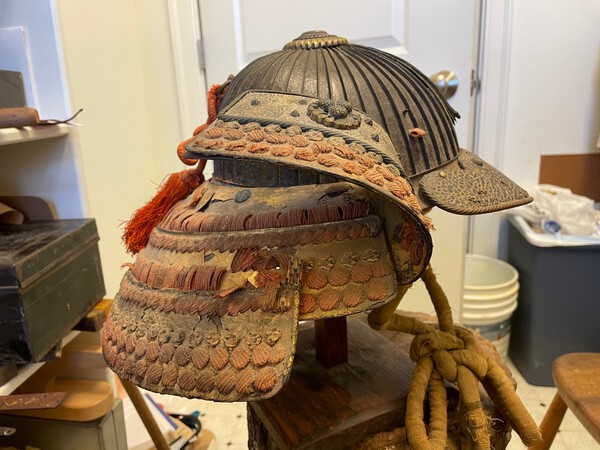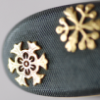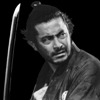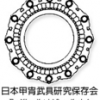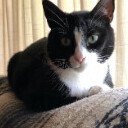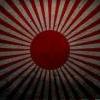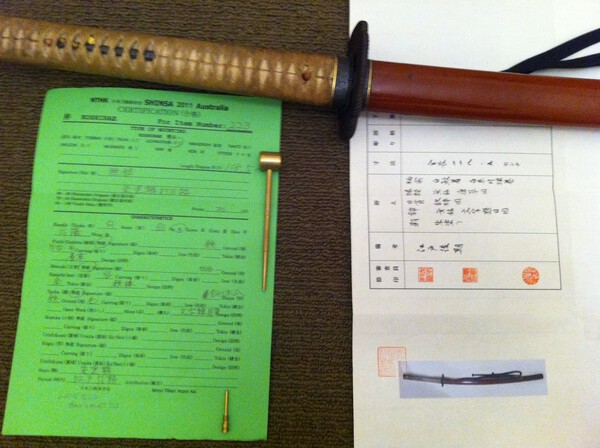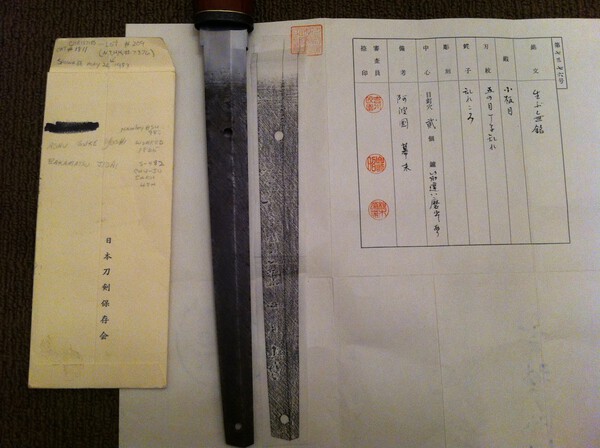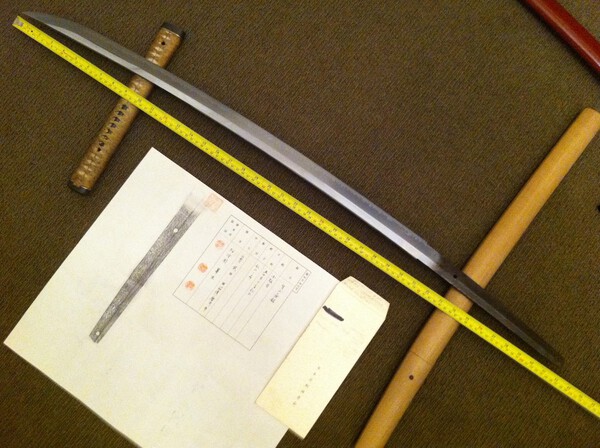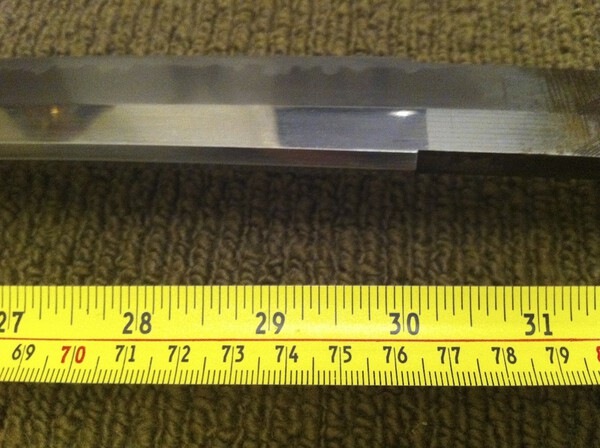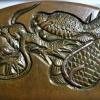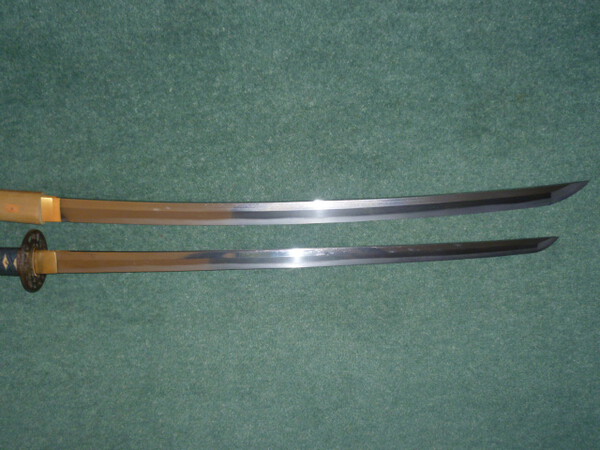Leaderboard
Popular Content
Showing content with the highest reputation on 01/18/2021 in all areas
-
There has not been a lot of school educational information in the Tosogu section for a while. I had some time off this morning and was compiling notes on a few of the Higo fuchi-kashira I own. I decided to save down to the public forum NMB some of what I've learned over the last 8 years with an interesting set. Nishigaki Yoshihiro- death date circa. 1780 ? coincides with the attributed 4th master of Nishigaki "Yoshiyuki". The details of the life of the two seem very similar. It is likely they worked in tandem as did nidai Kanshiro and his brother Nishigaki Kanpei. Given the ill health of Yoshiyuki, it is likely the Nishigaki work of the period was done by Yoshihiro. Much of the unsigned work of the period seem much more in the style of the sandai and directly of Yoshihiro. The scant Yoshiyuki work I have been able to find is not as well done as the sandai's excellent work, nor the conviction of Yoshihiro's work. Addition note: Yoshihiro work often reflects more of an Edo fashion sensibility rather than than Kyushu feel. Wave form fuchi-kashira dated 1776, probably done in August (not July) counting on the Chinese system calendar. Wave form, complete with Nishigaki signature tidal pool, is similar to the sandai. I have never yet come across a wave form work by Yoshiyuki, though I have seen signed excellent wave form examples by the 5th and 6th gen that are almost as active as Omori school waves.5 points
-
Dave I do not have any photo of that sword. I just translate the Kanji on that blade Stegel posted. And I noticed the similarity between the other mark on it and the KK mark on the Type 30 bayonet since Bruce asks about it. I always agree with the 應 marked blades were made in China for the puppet government. Collectors in China called those swords 偽軍刀 .Note,Is 偽軍-刀(Puppet Army Sword), not 偽-軍刀(Fake Gunto).4 points
-
3 points
-
2 points
-
John, You underestimate how lazy many of us are (myself included) and how many don't even bother opening links. If I were you, I would directly upload at least one or 2 overall pics, showing the entire blade. That will entice people to open the others.2 points
-
2 points
-
Ref. A Gendai blades mei translation help - Translation Assistance - Nihonto Message Board (militaria.co.za)2 points
-
This thread is why the NMB is worthwhile. Interesting object, reasonable challenge, wonderful assessment, and good company. What's not to like! Peter2 points
-
John, I think you have the makings of an article there. Fancy formatting it into a pdf and we can keep it for future readers in the downloads section?2 points
-
I'm back! The Tadayoshi did indeed make many styles of Hamon ---and the world recognised signature pieces were suguha. But not just any suguha….THE suguha. The forgers jumped on this bandwagon, and anything with suguha was faked into gimei Tadayoshi with varying degrees of signature quality from that akin to a 2 year old drawing in sand with a chopstick, to the Hizen Kaji itself adding the signatures. Some rare genuine pieces are in the more flamboyant choji midare, gunome etc and I suspect were special orders. The Oshigata books are full of them, but they rarely surface in the flesh, and when they do, they command very high prices and great care is necessary. The bulk of the works we see are therefore suguha- and in really nice suguha with some fine, often missed, ashi sometimes (4th and 5th if I recall correctly), and nijuba (2nd Gen), bright nioiguchi (2nd gen), nie deki in dark nie (1st gen) , flawless (3rd Gen)and so forth. Since the wilder hamon are buried deep in collections and rarely seen, the tendency is to assume they are gimei when they do show up. If you see a suguha sword, most jump straight to the Tadayoshi and if the hamon is lifeless, then clearly NOT the work of this school. The reality is that far more suguha gimei are out there, and unfortunately, some 85% of the overall Tadayoshi swords/oshigata/images I come across are in my opinion outright gimei, maybe 10% are in the 'not sure' bracket, and 5% have me drooling. The 10 % is the grey ‘floating world’ of gimei and all sorts of theories expound, but they can be really, really good. In short, its not JUST the signature, but the message the whole sword puts out. No I am not high! What I do when I see the wild hamon type swords is to put a great big question mark in the equation. In fact, the best approach is to not have any sword fever at all, and start with a gimei approach, the aim being to find signs that prove it is genuine and try to take the hoarder/gold fever attitude out of the equation as the heart beats faster. So the question is.... is this sword genuine. Since I presume no-one bought it who commented, it is now an easy option to say probably gimei, feel good about it and move on, but I don’t think that does this sword justice. I once saw an old collector at the SFO show years ago sit for two days behind the dealers table with a single sword he was contemplating buying – just getting to know it and listen to it he said! The sword, from what I can see (which isn't much) , doesn't have any obvious flaws and looks nice quality with a good colour to the steel. It gives an impression of quality, not junk. In no particular order...... The almost O-Kissaki and boshi is great with a Hizen type kaeri (I think that is what is there- an even tightish turnback without the wavy midare carried into the actual turn itself?). It’s a stoutly (very stout) proportioned sword, with an unusually short nakago and a signature that fills the nakago…… almost tsunobi tanto style --- so if it is only JUST a wakizashi in cutting length, then that's good news because there seemed to be a penchant for tsunobi (oversize 1 shaku 1 sun) tanto within this school (ie you don't often see small tanto, but you do see technically short wakizashi over 1 shaku, with tanto type proportions – tsunobi tanto), hence the rather short nakago ** (more later). Koshirae is possibly changed but ---glimpse of a Hizen Namban type of tsuba, a glimpse of lovely menuki in quality shakudo and gold, a glimpse of a silver dragon kanamono on the dried up saya ripe for restoration. Kind of points to a higher value owner than a hunter killer impoverished Samurai. Onto the nakago ----- well the nakago shape is good for the early generations, rounded V shaped nakagojiri, yasurimei are good quality, patina suggests maybe early Edo, if you go with a tsunobi tanto, then signature size and placement is kind of Ok. So I am thinking Hizen kaji work and haven't really seen anything to say it isn't yet. I love the powerful blade shape, and the short nakago maybe significant as the nakago wouldn’t be long enough to chop through your Xmas Turkey or opponents thigh bone in one stroke. The all important Mei. What I don't like: One chisel stroke in the Zen kanji runs into the nakago-mune. Hmmm. I would have been more comfortable if the mekugi-ana had pieced the left chisel strokes. Kind of suggests that the mei was added AFTER the mekugi ana and squeezed into place. I don't know what they did in this respect, but was told by an old Japanese sword master a few years back that the sword was a utility weapon, and was made into a sword after the smith made it. So you would expect the entire sword blade including the signature to be made first, and the hole placed later by the person fitting the koshirae who was more concerned with fitting the tsuka than the smiths signature. Not sure on this point but it makes sense........( Incidentally he also said once a sword was chipped or damaged, it was retired from use since your life depended on its structural integrity. I would suggest that depended on the depths of your pockets. I digress but all those Sengoku Jidai battle blades we collectors hold in high esteem with hakobori he thought of as junk!). What else is not right ......Kanji spacing is a little suspect but hard to discern on an oblique picture. The bottom TADA and YOSHI seem wider apart than the upper kanji ---almost as if they are set apart from the rest of the signature to say – “look at me ---- and don’t look anywhere else”- could be the angle but it is a question mark in the process. I usually run on 3 strikes and you are out--- right now we have a (probably) tsunobi tanto shape ( ** more later) but not a problem , with a wilder hamon than usual, again not a problem but care should be exercised, possibly awkward spaced kanji (maybe a problem) and a stroke runoff the edge (problem). What I do like : the vertical stroke in the kanji Tada is exactly correctly placed for X smith. The kanji are well cut, and let’s face it, up there with the actual smiths. Whoever applied this signature was in the upper end of his knowledge of this school, whether it was a master himself, or very good faker, or ......... the kaji itself. None of the kanji are out of place for this school in terms of shape and stroke ---none that I have spotted yet! We now take a while to let this sink in before returning to the kanji, and digress a little. The same Iaido master in Tokyo told me (and who am I to doubt him), that the castles in the castle towns were also repositories for weapons. Swords were stockpiled in times of peace for times of war. Thousands of them. And significantly many/most/all? were unsigned as they were churned out by the deshi and masters for the stockpile. The finest pieces went as gifts or were sold, the rest into the stockpile – unsigned. When hard times fell upon the Samurai (1800's onwards) and the CEO (Daimyo) was looking for cutbacks --- guess where the stockpiled swords ended up! Back in circulation ... but mumei swords were plentiful and what was required were swords made, and more significantly signed, by the masters (who were now dead). Add this to the grey production lines that the Daimyo did not control , and hey presto the actual 4th Gen sword with a faux 4th gen signature becomes reality... kaji made 'gimei'. Yup --- this throws a big spanner in the sword world... thank goodness it isn't rife in the armour world! I have that sword – a 4th gen blade, with a 4th gen signature, dated 1819 (8th gen was around 14years old). Un-papered of course but everything screams 4th gen except the inscribed date (which if anyone is aware is smack in the middle of the leaderless Kaji as the 8th gen was still too young, and the 6th & 7th recently departed this world)! Back to the ** short nakago issue. The same Iaido Master also told me that if you ever see a disproportioned (in length) nakago on a wakizashi size sword, it is PROBABLY a merchants sword. Remember they didn't fight, and could not wear a katana being limited to wakizashi. They carried fine pieces, high quality, but of little real fighting use due to the shortened tsuka. There was simply no need for a larger tsuka because if the merchant ever put his hand on it, he would probably be cut down in the blink of an eye. Best not touch it! They could afford the masters works and the flamboyant hamon, and often glamorous koshirae, and wanted the signed pieces. I am also thinking no self respecting trained killer of a samurai is going to put a silver kanamono dragon on his ro-iro saya. Incidentally the old Iaido Master’s grandfather was friendly with a local Daimyo, and they both had a passion for swords (he showed me the photo at his house one evening). Anyway, the Iado Sensei inherited the old family house, and had it restored. He found over 160 swords stashed in the attic and was slowly selling them off (I bought a few over the years) including a really nice Shodai Tadayoshi leaf yari that papered– and the usual bunch of (subsequent) gimei other smiths – stick to what you know! So that is where I am at with this sword --- possibly a tsunobi tanto, (someone is now going to post its length as 1 shaku 9 sun or something, rather than 1 shaku 0 Sun 8 Bu and shoot me down ! ), possibly a merchants sword in nice koshirae, and I would give it a shot at 80% genuine 1st gen and worthy of more research -note I did not say Shinsa in Japan as the last few swords I sent a while back to the NBTHK came back Horyu (undetermined). Did I say 1st gen? Slip of the pen but it got everyone’s attention. I am still pouring over the oshigata references, but I like it and am actually leaning towards 1st gen C1621 or a good gimei (not run of the mill). The ONE kanji that really cracks the Shodai question is the top of the HI kanji and the number of strokes top right – which was 3 for the Shodai and 2 for the other smiths – and that is the kanji we don’t see here (funny old thing)! The only solace is that had there been a couple of serious bidders, it could have hit a much higher price way outside of my now wife limited retirement budget of $4 per month. Had I seen it earlier and posted this, I guess the price would have been a lot higher than the rather pitiful $2,000 (sob sob). It is not 100% gimei and IMHO worthy of further research, and despite my setbacks with the NBTHK, even (dare I say it) worthy of Shinsa, otherwise known as “passing the buck” Hopefully some insight into suguha hamon, and gimei/shoshin appraisal (of Tadayoshi). Don’t you just hate it when a potential bargain slips past in the night! Rog2 points
-
I have written this post as an aid to tsuba newbies, like myself, who may buy Nagoya-mono tsuba while mistaking them for Mino Goto shakudo tsuba. Examples of Nagoya-mono tsuba have been discussed many times on the NMB and I offer this post as a collation of examples from what I believe is a single workshop. Nagoya-mono (alternatives Nagoyamono or Nagaoya mono) literally means ‘Nagoya object or thing’, i.e. something from Nagoya. Sometimes they are called ‘shiiri-mono’; literally ‘thing off the self, or stock item’. There are various types of Nagoya-mono and this post is a collation of the wakizashi size, mokko shaped soft metal tsuba that superficially resemble Goto workmanship that I believe were produced in the same workshop. I must declare at the outset that I am not an expert on the subject and the notes below are based upon my observations and what little information I have been able to glean from the literature. So please feel free to correct and comment. I first came across these tsuba two years ago when two were offered for sale at a large London auction house and catalogued as ‘Mino Goto shakudo’. Fortunately, a slow internet failed to register my over the top winning bid. A couple of months later I purchased two (a lot cheaper) as part of a mixed lot and others keep popping up in online auctions both in the UK and abroad, including Japan. This prompted an interest (though not a love) in these tsuba and a concern that they were being (possibly inadvertently) advertised as more desirable Mino Goto tsuba. For example, there is a tsuba of this type to which has been added a ‘Soten’ signature on Ebay for over £2000! The general features of these particular Nagoya-mono are: 1 Mokko shape and wakizashi or small katana size size (my two are 6.8 x 6.1 cm). 2. Although looking like shakudo, the metal is probably nigurome, an alloy of katashirome (tin and lead) and copper, which only becomes shakudo after gold (3-7%) has been added (Christies Compton collection description). Whether this is true nigurome, i.e. the base alloy for shakudo, or a similar alloy better suited to casting and patination I cannot say. 3. The colour of the body (ji) of the tsuba resembles the blue black of shakudo but lacks the depth of colour and often has a brown tinge to it. The seppa-dai is always chocolate brown in the ones that I have seen. 4. The ji is not perfectly flat, as in Goto works, but often shows shallow undulations caused by uneven casting. 5. The nanako finish is not great. I thought that it was probably cast rather than made with a punch. However, comparing the nanako on one of my tsuba with that of a photo (on-line) of an identical tsuba showed differences. This may indicate the nanako was applied by hand (using a punch), or from using different moulds when casting the tsuba. 6. The mimi and hitsu ana are usually surrounded by a gold gilt finish that initially looks like regular nanako, but on closer examination looks like a lizard skin, i.e. shallow and with bigger oval spots (see pic). 7. Most have a single kodzuka hitsu ana, but some have both kogai and kodzuka hitsu ana. 8. Silver and gold gilding looks as if it has been applied by painting with a mercury amalgam and then heating to vaporise the mercury. I have not seen any evidence of gold foil peeling off the tsuba. I conclude that although cast, individual tsuba are finished and decorated by hand. I have not seen seams from the mould either, unlike cast iron tsuba. 9. Lastly, these Nagoya-mono tsuba have a characteristic pattern of ten punch marks around the nakago ana, viz: three at the top, two on each side at the bottom and three along the bottom. These differ slightly in position, so were evidently made individually and some have been altered. I think that these were quality control marks to indicate they were deemed good enough to sell. As soon as I see these I want to shout ‘Ah, another tsuba from Mr Suzuki’s workshop.’ Note: I don’t actually know the name of the workshop owner. So, who originally bought these tsuba? I don’t think it was tourists (Japanese or European) as has been suggested. There were few in the Edo period. Poverty and starvation were rife in the 17th and 18thC, so they may have been bought by poor samurai or by wealthier wannabe merchants, who were allowed to wear short swords. A bit of bling to wear on Saturday nights maybe. Many men throughout history and throughout the world have woken up after a night on the town only to find that they had ‘mislaid’ their money, valuables and sometimes their clothes. A wise man would leave his valuables at home. Although dismissed by many on the NMB, I see no reason why a collector should not specialise in Nagoya-mono, especially if they are not wealthy enough to buy genuine Goto works and have no interest in ‘bits of old iron’. However, some of the ones I have seen for sale have gone for over £300/$400, which I think is way too much! There are plenty to study in addition to those from Mr Suzuki’s workshop. So here is my collection of 16 designs (there are others) that I have come across in the last few months, all apparently from ‘Mr Suzuki’s workshop’. Two of them are mine (they were just included in job lots, honest!). I have also included a picture of the ‘lizard skin’ nanako on the mimi of one of mine for reference. 1. Takarabune (treasure ship) with the character Hoo (treasure) on the sail. This tsuba is mine 2. Chrysanthemum, birds and fence. This tsuba is also mine 3. Flowers in basket on wheelbarrow 4. Tadamori catching the oil thief 5. Man chasing snake 6. Pagoda and water wheel 7. Shishi 8. Ho-o bird on branch 9. Chrysanthemums 10. Meadow flowers 11. Five Chinese sages 12. Thatched hut scene 13. Two deer and flowers 14. Dragon 15. Lady Murasaki Shikibu writing 16. Peacock Regards, John (just a guy making observations, asking questions, trying to learn)1 point
-
Dear NMB Friends, I am writing to the NMB for expert advice and counsel. Please tell me what I should do with a kabuto I have owned for years and sort of ignored. It is an early post-War bring back that came to me as a rather delicate basket case. I think it is time for me to either 1) attend to it, or 2) find it a new home. It is a 41 plate kabuto with an intact ukebari (liner) so I don’t know if it is signed or not. The shikoro is detached but all there. Likewise, the maedate and mempo are there but in pieces.1 point
-
A recent auction sale https://www.jauce.com/auction/d477991218 had, what you are led to believe are a daisho of tsuba. From what I see they are totally unrelated, the smaller of the two pieces looks ok [a bit of an indent at the bottom] A very fine fukurin, the sukashi look ok [a bit dusty]. But check out the larger piece, that full flower head, the 'kebori' on the leaves - all a bit off. But the ura side is where the game is up! The lower stem of the Chrysanthemum has casting bubbles but the fun inclusion is the Chinese star on the flower head - I know a star is a star and the symbol is common in many cultures, but that is my take on it. Now another intriguing feature are the ategane/ume, they don't look like they were made to fit this guard at all, but came from some former jewelry piece - the detailing on them out weighs the tsuba. I would be interested in others thoughts.1 point
-
Dale, I received the two volumes of books on the Tsuba in the Metropolitan Museum of Art, and am very pleased with it. I have been going through Volume 1 and will head to Volume 2 next. Even though the artist name is not included for every item, it is for most and the book would benefit from an index. If I can be disciplined enough, I will try to do that for myself.1 point
-
Hi again Mark, Patina is natural and is mostly affected by the hand of the owner. It is customary to hold the sword unprotected by the nakago when you clean the sword. Sweat and any humidity from the hand will naturally add patina to the nakago although, yes, external factors also play a role (climate, etc). So patina is a very important asset when judging the age of a blade. It isn’t always accurate of course, but on an ubu sword like yours, it’s a good indicator of age. moreover, don’t forget that the only part being polished from time to time is the blade, not the nakago. You should never temper with the patina of a nakago or the sword will lose a lot of value. So judging by the patina, this isn’t a very old sword (note: not being very old doesn’t mean bad. There are excellent Shinshinto swords). The signature doesn’t look too good, honestly. It lacks precision and consistency I think. The file Mark being very visible is another clue to a rather recent sword. Finally, the katana is an evolution of the tachi. I don’t think I’m making a mistake by saying they appeared after that particular swordsmith lived. So if I am correct, Shigeuji would have made a tachi, not a Katana. Besides, most of the swords from that age have been shortened, yours haven’t. So the conclusion is probably Gimei. Which, again, doesn’t necessarily mean a bad sword, just a false signature.1 point
-
1 point
-
this is how yo can make the inside visible. Sorry but this ukebari is seriously damaged due to it's age. Notice the skillful finishing of the rivets on the inside, the perfect carved mei, the high number of rivets per plate, etc... All these fine details would be lost with a closed ukebari. Even important museums such as the Ueno in Tokyo are opening ukebari if they expect to find more information. This has nothing to do with destruction.1 point
-
Rich. Well there is another one in a bunch of five pretty ordinary types - currently listed for 1 yen https://www.jauce.com/auction/v776969718 Now that is real money!1 point
-
Dale Glad to know my tsuba isn't totally worthless That's more than I paid for mine. Rich1 point
-
Sorry, we are not advocating vandalism. But how can one seriously study swords without seeing the nakago? How can one seriously study kabuto without seeing the inside of the hachi? There are clean ways to see the inside, without damaging the kabuto.1 point
-
1 point
-
This is where I downloaded the picture in my files. It was posted back in 2015. Possibly this is one of the sources of the picture. Arsenal Stamps.1 point
-
1 point
-
Good job, Dave. That's the gunboard thread I mentioned in my earlier comment. I tend to believe that these are Chinese made swords, for collaboration forces and maybe Japanese officers in need...? I enjoyed reading this, Thomas. I have a couple of swords with what I believe is artificial leather of some kind on the saya. They look similar to the presstoff.1 point
-
Not 4th gen either. https://page.auctions.yahoo.co.jp/jp/auction/g476522615 So that leaves 2nd, 3rd, 5th(?), or 7th(?), or the other possibility of gimei. Still, to me it is an extremely interesting rare design. If I have seen this design in menuki before, I do not recall it. -->Early in my interest in the hobby, I had a pair of "drunken gaijin under a lamp-post" menuki. The older Japanese at the NY Metro club had a good laugh at them. I didn't know how atypical they were at the time. I've never seen their like again.1 point
-
Jesse M, If you like to read how barn finds turn out this one is a doozy: BaZZa.1 point
-
I like this...shows a lot of promise. And if it is decent, you are very lucky to have Andrew in Oz who can polish and restore it. We all await news.1 point
-
Please ask the seller for the dimensions - I promise you this is no more than 50 cm high...1 point
-
Kyle has been put in touch with a highly esteemed Board member who lives close to his area. We may await more news with bated breath... BaZZa.1 point
-
You are correct Mark. I have gone through them and rated them 1, 2 and 3. I will study the 1s and then the 2s, taking photos and building a file on each of them. I bought a Dymo labelmaker and it can support kanji, so I will make labels for the boxes (or tags if there is no box). It should take considerable time but be fun and stimulating.1 point
-
G'day Kyle, Your photos are good enough to show you may have a good, old blade in restorable condition. Do nothing to the blade at present except to wipe it with a cloth or tissue using sewing machine oil, then clean off the excess. As for the mekugi, don't worry about it all at all as it is replaceable with a bamboo chopstick whittled to shape. Get it out as carefully as you can and let us see the tang photographed from both sides with the habaki off. The tsuba appears to be an old one and the whole rig looks as if it has had a hard life in the back of a shed. The blade is the very most important thing that should capture our care and attention. A close up photo of the kissaki (point) would be good, both sides. With the habaki off also p[ease give the length measured from the back notch in a straight line to the point. Fingers crossed for you. Best regards, BaZZa, aka Barry Thomas Melbourne, Australia.1 point
-
Dear Robert. I think Piers' advice is good, you just need to weed out some of those. As a fellow collector I would be happy to ease your burden and take some of the less significant pieces away from you, provided that you will accept my advice on which ones to let go. Seriously a lovely selection and I would find it difficult to let any of them get away. To borrow a cycling aphorism, "The correct number of bikes you should own is the number you have now plus one." Enjoy! All the best.1 point
-
Not sure what your problem is. I've bought several blades from Mike, & all but one papered. Can't get much more "collectible" than that!1 point
-
As they say you learn by your mistake's.I to have been sucked in by this seller i bought a blade signed Endo Mitsuoki and thought it was a bargain, Before it arrived i sent him a message asking if he had a habaki for it and when in ww2 was it made this is the reply. komonjo: Hi Vic, This is much more recent than WW-II. Bare blades I list are consignments from a Japanese dealer. He says he gets them from wholesale dealer auctions, but I don't think so. It is nearly impossible to see so many gendai bare blades in auctions. I think he has either a starving sword smith or an apprentice making them, then adding a recognized names on them for marketing purpose. The blades who all the signs of being traditionally forged and tempered, but I don't trust the signature. They are marketed for martial artists who want solid traditional blades but priced lower than antique ones. From some feedback I got from past buyers, they are darn good cutters. Regards, Your previous message I am new to collecting Japanese's swords is this blade from WW2 cheers Vic. komonjo: Hi I don't make or sell habaki. Sorry, Your previous message Hi There do you have a habaki to fit this blade that i could buy cheers Vic. Your previous message Oh s**t i have a lot to learn i can,t believe i just bought another fake, Hope it is not made in China New message from: komonjo (4,183) Hi Take a look at it with your eyes, and show it to your friends. I don't think Chinese are capable of producing this kind of blade, yet. I say YET because they've come a long way since their fakes started appearing on eBay in the early 2000s. But I don't they've reached this level. Also, this is circumstantial, but the fact that they are consignments from a dealer in Japan tells me that their chances of being Chinese fakes is very small. Japan has very tight regulations about bringing in swords from abroad. In order for them to come into Japan legally, they will have to be un-edged "decoration" swords. To import them in that condition, and then polish and sharpen them into the current shape would make them too costly, I think. Best,1 point
-
I bought my Borescope on ebay for £5.95. $8.07 US including Free UK Delivery. Comes with a neat 45% attachment.1 point
-
Bruce IJA use 曹長 Sergeant Major 軍曹 Sergeant 伍長Corporal, those guys normally wearing NCO sword. https://en.wikipedia.org/wiki/Ranks_of_the_Imperial_Japanese_Army IJN use 一等兵曹 Petty officer first class 二等兵曹 Petty officer second class 三等兵曹 Petty officer third class https://en.wikipedia.org/wiki/Ranks_of_the_Imperial_Japanese_Navy1 point
-
This is my beautiful monster! made by Edo period smith Ashu Sukeyoshi I think that it may be one of the biggest swords in sydney or maybe even australia.....please prove me wrong. Both the blade and the koshirae have NTHK kantiesho origami and it has been suggest that this koshirae was crafted at the same time and is the first and only koshirae fitted to this blade ever. making this a totally authenticated original massive ensemble. The Pride of my collection Enjoy Herman W1 point
-
1 point
-
1 point
-
1 point
-
I look more like a cross between Columbo and Patrick Stewart from Star Trek! My hair has 'boldly gone'0 points












